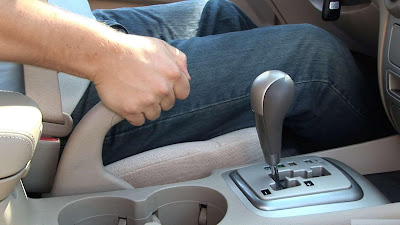The emergency brake of a car, otherwise named parking brake or hand brake, is a purely mechanical system. Unlike most “regular” car brakes that are operated by hydraulics, emergency brake of a vehicle is operated by a system of cable(s) and springs, which is covered by a sheath. In cold environmental condition, many times it so happens that water gets trapped inside the sheath and freeze solid. The ice then prevents the cable inside the sheath from sliding thereby making the entire system inoperative. Jamming of the cable by dried dirt and grease is also a common phenomenon with parking brakes. In such situations, it takes a lot of time for the hand brake to get back to its normal operational state. But if you know the tricks you can thaw it easily. Here's how you do that:

First, start the car engine. Then release and set the hand brake repeatedly in order to dislodge any frozen solid particles from inside the brake system.
If the emergency brake is still frozen, block as much of the open space between sides of the vehicle and the ground.
Now, shovel snow or pile up other material along the sides of the car. The objective of doing this is to create an airflow path from front to the rear of the car so that any "losses" from the under the sides of the vehicle are minimized.
Then leave the car ALONE for sometime, and allow it to "warm up". Once the car engine has warmed sufficiently, the heated air pulled through the car radiator and heat created by the car exhaust system will pass under the entire length of the vehicle. This will expedite the entire thaw process significantly.
Finally, attempt to release the parking brake or hand brake again. If you find it still frozen, allow some more time for the brake system to thaw, and/or block any remaining open spaces at the front and rear of the vehicle. To increase the heat generated therein, depress the accelerator slightly. This will speed up the mechanical fan of the car engine, and force more hot air underneath the vehicle.
While doing all these, make two things sure- the end of the car exhaust pipe is not be obstructed in any way, and the exhaust gases from it is not trapped under the vehicle.
Follow these few simple steps, and your car emergency brake will soon be operational.
If the emergency brake is still frozen, block as much of the open space between sides of the vehicle and the ground.
Now, shovel snow or pile up other material along the sides of the car. The objective of doing this is to create an airflow path from front to the rear of the car so that any "losses" from the under the sides of the vehicle are minimized.
Then leave the car ALONE for sometime, and allow it to "warm up". Once the car engine has warmed sufficiently, the heated air pulled through the car radiator and heat created by the car exhaust system will pass under the entire length of the vehicle. This will expedite the entire thaw process significantly.
Finally, attempt to release the parking brake or hand brake again. If you find it still frozen, allow some more time for the brake system to thaw, and/or block any remaining open spaces at the front and rear of the vehicle. To increase the heat generated therein, depress the accelerator slightly. This will speed up the mechanical fan of the car engine, and force more hot air underneath the vehicle.
While doing all these, make two things sure- the end of the car exhaust pipe is not be obstructed in any way, and the exhaust gases from it is not trapped under the vehicle.
Follow these few simple steps, and your car emergency brake will soon be operational.














